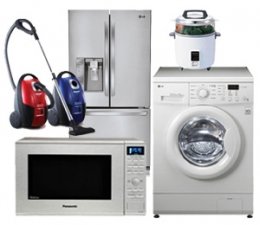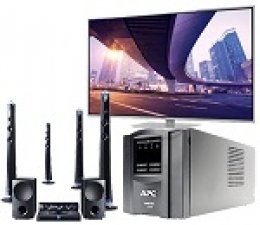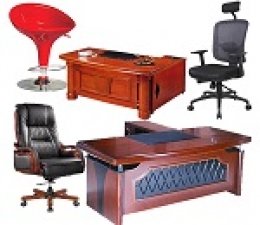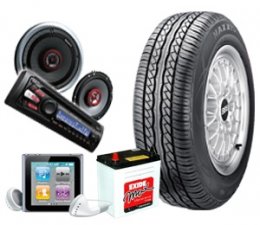TV ACCESSORIES
A television antenna, or TV aerial, is an antenna specifically designed for the reception of over-the-air broadcast television signals, which are transmitted at frequencies from about 41 to 250 MHz in the VHF band, and 470 to 960 MHz in the UHF band in different countries. Television antennas are manufactured in two different types: "indoor" antennas, to be located on top of or next to the television set, and "outdoor" antennas, mounted on a mast on top of the owner's house. The most common types of antennas used are the dipole ("rabbit ears") and loop antennas, and for outdoor antennas the yagi and log periodic.
Description
To cover this range antennas generally consist of multiple conductors of different lengths which correspond to the wavelength range the antenna is intended to receive. The length of the elements of a TV antenna are usually half the wavelength of the signal they are intended to receive. The wavelength of a signal equals the speed of light (c) divided by the frequency. The design of a television broadcast receiving antenna is the same for the older analog transmissions and the digital television (DTV) transmissions which are replacing them. Sellers often claim to supply a special "digital" or "high-definition television" (HDTV) antenna advised as a replacement for an existing analog television antenna; at best this is misinformation to generate sales of unneeded equipment, at worst it may leave the viewer with a UHF-only antenna in a local market (particularly in North America) where some digital stations remain on their original high VHF frequencies.
Simple/indoor
Simple half-wave dipole antenna for VHF or UHF loop antennas that are made to be placed indoors are often used for television (and VHF radio); these are often called "rabbit ears" or "bunny aerials". because of their appearance. The length of the telescopic "ears" can be adjusted by the user, and should be about one half of the wavelength of the signal for the desired channel. These are not as efficient as an aerial rooftop antenna since they are less directional and not always adjusted to the proper length for the desired channel. Dipole antennas are bi-directional, that is, they receive evenly forward and backwards, and also cover a broader band than antennas with more elements. This makes them less efficient than antennas designed to maximize the signal from a narrower angle in one direction. Coupled with the poor placing, indoors and closer to the ground, they are much worse than multi-element rooftop antennas at receiving signals which are not very strong, although often adequate for nearby transmitters, in which case they may be adequate and cheap. These simple antennas are called set-top antennas because they were often placed on top of the television set or receiver.
Outdoor
An outdoor TV antenna generally consists of multiple conductive elements that are arranged such that it is a directional antenna. The length of the elements is about one half of the signal wavelength. Therefore, the length of each element corresponds to a certain frequency.
In a combination (combo) VHF/UHF antenna the longer elements (for picking up VHF frequencies) are at the "back" of the antenna, relative to the device's directionality, and the much shorter UHF elements are in the "front", and the antenna works best when "pointing" to the source of the signal to be received. The smallest elements in this design, located in the "front", are UHF and use Yagi antenna principles. The longest elements, located in the "back" of the antenna use VHF Log-periodic principles. Combining these two types of antenna creates the combination VHF/UHF antenna commonly used.
Two or more directional rooftop antennas can be set up and connected to one receiver. Antennas designed for rooftop use are sometimes located in attics.
Sometimes television transmitters are organised such that all receivers in a given location need receive transmissions in only a relatively narrow band of the full UHF television spectrum and from the same direction, so that a single antenna provides reception from all stations.
Installation
Antennas are commonly placed on rooftops, and sometimes in attics. Placing an antenna indoors significantly attenuates the level of the available signal. Directional antennas must be pointed at the transmitter they are receiving; in most cases great accuracy is not needed. In a given region it is sometimes arranged that all television transmitters are located in roughly the same direction and use frequencies spaced closely enough that a single antenna suffices for all. A single transmitter location may transmit signals for several channels.
Analog television signals are susceptible to ghosting in the image, multiple closely spaced images giving the impression of blurred and repeated images of edges in the picture. This is due to the signal being reflected from nearby objects (buildings, tree, mountains); several copies of the signal, of different strengths and subject to different delays, are picked up. This is different for different transmissions. Careful positioning of the antenna can produce a compromise position which minimizes the ghosts on different channels. Ghosting is also possible if multiple antennas connected to the same receiver pick up the same station, especially if the lengths of the cables connecting them to the splitter/merger are different lengths or the antennas are too close together. Analog television is being replaced by digital, which is not subject to ghosting.
Safety
TV antennas are good conductors of electricity and attract lightning, acting as a lightning rod. The use of a lightning arrestor is usual to protect against this. A large grounding rod connected to both the antenna and the mast or pole is required.
There is inherent danger in being on the rooftop of a house, required for installing or adjusting a television antenna. British entertainer Rod Hull died after falling from his roof where he had been trying to improve reception for a football match.
How to Buy a TV Antenna
With so many local television stations now offering up to 4 sub-channels in addition to the lineup on the main channels of programming, the idea of jettisoning cable and satellite services in favor of over the air options has attracted a lot of attention. By choosing the right television antenna, it is possible to enjoy an equitable number of channels without paying anything. When buying a TV antenna, it is important to consider several key factors, including size, type, range, gain and ease of installation. Price is also an important consideration since paying more money may or may not mean better reception.
• Think about the size and type of TV antenna you have in mind. For people living in a high rise apartment in a metropolitan area, a simple indoor antenna that can be placed discreetly on the top of a television cabinet will often pull in all the local channels and sub-channels with ease. People living in 1-story houses located in that same area may find that an outdoor antenna that can be mounted on the roof or at least on the upper casing of a window may be necessary in order to receive those same channels. Renters will need something that is relatively small in scale and can be mounted and removed with ease, while homeowners can go with one that is larger and more permanent.
• Evaluate the range and gain that the broadcast antenna is likely to provide. Most antenna producers make certain assumptions when identifying the average range of an antenna, such as the level of the general terrain and the antenna being suspended a certain level above the ground. Take the average range and gain with a grain of salt if you live in hilly country or a low-lying area of the city.
• Consider the ease of installation. For an indoor antenna, all that is usually required is plugging the unit into a digital converter box attached to an analog TV set or directly into a newer high definition set, and then positioning the antenna for the best reception possible. Outdoor antennas may require running additional cable as well as mounting brackets that can be used to keep the antenna in position.
• Determine the ease of use associated with a particular design of TV antenna. Many outdoor antennas are equipped with remote controls that make swiveling the antenna a simple task. This is in contrast to the antennas of decades past that had to be turned manually in order to bring in different channels.
• Compare the costs. The TV antennas of today are often compact, with some indoor and outdoor models being as small as the average magazine. Cost does not necessarily mean greater range or gain, although you will pay a little more for an antenna that is omni-directional or capable of picking up signals coming from multiple directions. If you live east of all the broadcast towers in town, going with a less expensive antenna that picks up signals from one direction will work just as well as the more expensive models,
Looking for quality antennas, visit our online store today. Log on to www.deluxe.com.ng and get your items delivered to your doorstep.







